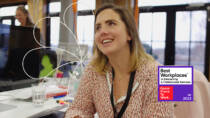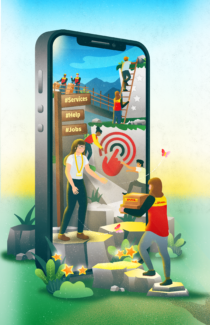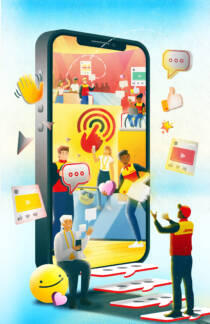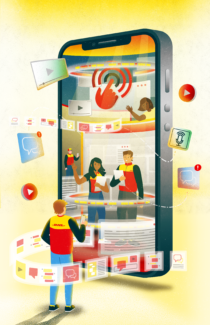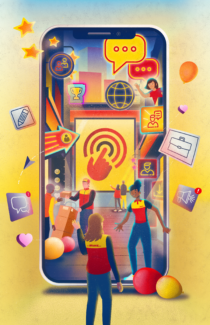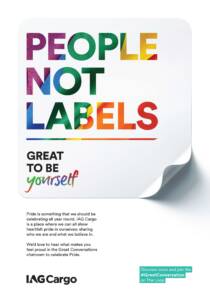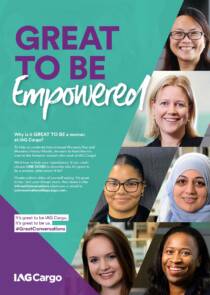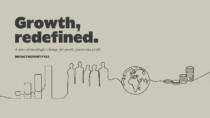We're one of UK’s Best Workplaces in Consulting & Professional Services
By Sally Pritchett
CEO
As a creative communications agency, we've always put our people at the heart of our success, and this recognition underlines our strong commitment to creating a positive and thriving workplace culture.
We’re excited to share some fantastic news: Something Big has earned a spot in the respected UK’s Best Workplaces in Consulting & Professional Services™ list by Great Place to Work®. In the world of professional services, every interaction our team has with our clients, every project they complete, and every deadline they meet, contributes to our success. Our approach has always been simple but powerful: when our team feel happy, respected, psychologically safe and connected to our purpose, our creative is powerful, our clients succeed, and our business flourishes.
What is the UK’s Best Workplaces in Consulting & Professional Services list?
The UK’s Best Workplaces in Consulting & Professional Services™ list encompasses a broad range of knowledge-intensive roles, from legal services to management consultancy, engineering, marketing and advertising, telecoms, real estate, recruitment, travel management and more. It showcases the rich diversity of talents driving the industry forward.
The Best Workplaces in Consulting and Professional Services™ list is created using anonymous feedback from employees working in the industry about their workplace experience. The surveys asked employees to comment on how their company supports their work-life balance, sense of fulfilment, job satisfaction, psychological safety and financial security. Evaluations also included an assessment of how well the organisation was able to deliver consistency of their employee experience across all departments and seniority levels.
Benedict Gautrey, Managing Director of Great Place To Work® UK said: “While navigating this ever-changing landscape, the Best Workplaces in Consulting & Professional Services have galvanised their people proposition by placing employee wellbeing at the forefront of their company cultures – and enjoyed better business performance and staff retention as a result. It’s great to see so many examples of organisations making their workplaces truly ‘great’.”
Our commitment to our culture
At Something Big, nurturing a thriving workplace culture is vital to the success of our business. This belief has been embedded in our values for 25 years, and now, as an employee-owned certified B Corp, our dedication to our people is stronger than ever. To discover how we maintain an outstanding culture for our business’s success, check out our CEO’s article.
Join us on this journey
If you’re on a mission to foster a positive workplace culture and are looking for a creative communications agency that not only partners with one of the World’s Best Workplaces™, but also lives and breathes those principles within its own team, we’d love to hear from you.
Reaching the frontline: How to engage hard-to-reach employees
By Sally Pritchett
CEO
Discover how to effectively engage hard-to-reach employees with inclusive internal communications.
Accessible and inclusive internal communications play a key part in creating and maintaining a thriving workforce. But when it comes to large, multi-level organisations, how do you communicate to such a wide and varied audience?
Frontline workers in particular pose a unique challenge as, by the very nature of their active job role, they are usually the hardest to reach. Without access to a laptop or sometimes even a work email account, it’s a challenge to ensure these employees are receiving important messages and are aligned with company values.
And although being away from a desk can have plenty of benefits, it’s these frontline workers who could benefit the most from inclusive communications. By reaching these employees, we can help them avoid any feelings of isolation or disconnectedness from the business while they are out on the frontline.
So, what is the best way to reach every employee, even those that are hard-to-reach? Clear and accessible communications, cutting through the noise and using a wide range of channels are just a few ways we can make sure our messages are engaging the whole workforce.
Case study: Launching a global employee app for DHL Express
DHL Express asked us to help them launch Smart Connect – an internal employee app and social intranet for DHL employees to help manage their work and stay connected. The aim of the app was to connect all 120k employees, providing news, HR services and info pages.
They explained that uptake of a previous internal app had been low, so it was important to get this launch right so the new app didn’t suffer the same fate.
We needed to be able to engage a diverse range of employees – across borders, language barriers and hugely different roles. It was also important that people felt confident to download the app onto their own personal devices, as many frontline workers didn’t have access to a work computer.
The client had also found that although DHL Express has a strong and consistent brand identity, this wasn’t always resonating with employees for internal communications.
Our approach to engaging hard-to-reach employees
So, how did we go about grabbing the attention of thousands of employees across offices, service centres, and out on the frontline?
-
We gathered employee feedback
We wanted to understand the barriers to adoption, the challenges of reaching the workforce and what would capture DHL employees’ attention.
-
We dived deep into the app experience
Training calls helped us better understand the app’s key features. This meant we could focus the campaign on areas that would have the biggest impact on employee experience.
-
We stepped away from the norm
By using bespoke and attention-grabbing illustrations, we ensured the launch would have cut-through amongst other internal communications.
-
We created a ‘portal to possibility’
We positioned the employee’s phone as the doorway into the world of DHL Express. Bright and energetic depictions of employees interacting with messages and pages leapt out of the phone, larger than life.
-
We used a wide variety of comms channels
With highly diverse employees based all over the world, we rolled out the campaign across a variety of channels including posters, internal TV screens and roadshows. We knew we had to make the comms as engaging and accessible as possible to be able to reach everyone across the business.
By working closely with the DHL Express team, we were able to successfully roll out the ‘A portal to possibility’ campaign. The innovative approach combined with accessible content captivated employees, surpassed prior downloads and engaged all regions and roles.
Let’s talk to see how we can help you create highly inclusive and human-centric campaigns that engage hard-to-reach employees.
8 strategies for effective internal communications
By Sally Pritchett
CEO
Discover the power of effective internal communications as we delve into eight strategies that can elevate your communication initiatives.
Internal communications departments are busier than ever. Along with the usual business updates, you are now communicating on a growing list of topics from employee wellbeing to allyship, and purpose to sustainability. Technology has brought new channels like employee apps and forums that require community management and maintenance. Workplace culture is going up the corporate agenda. And to add to this noisy and busy internal communications world, the volatile and uncertain environment businesses are operating in is throwing a never-ending set of curve balls at you.
It’s no wonder then, that it can be hard to pause and reflect on what’s working and what’s not. Grab a coffee and let’s take some time to review what strategies drive effective internal communications.
1. Leading with accessibility
From accessible channels to the way communications are written, your message can only get through if it’s accessible. Let’s look at a few things that often get in the way:
- Literacy exclusion: In the UK, the average reading age is 9-11 years old meaning that many communications could be inaccessible to large parts of your workforce. To overcome this, lean on your trusty AI tools to help you simplify the messaging.
- Digital exclusion: We recently talked about the findings of the Communication and Digital Committee report which served as a great reminder that not all of our workforce have access or the capability to access digital channels. You can combat this by ensuring more traditional channels like posters, noticeboards and newsletters are still available.
- Neurodiversity exclusion: From careful font choices to breaking up text, and changing coloured backgrounds to introducing text-to-speech tools, there are so many opportunities available to help make communication more accessible. To make communications more effective and equitable, offering reasonable adjustments to increase accessibility is a must.
2. Going beyond broadcast
A helpful perspective on your communication channels comes from the recent Gallagher Internal Communication and Employee Experience State of the Sector Report, categorising communication channels into three distinct buckets:
- Broadcast channels: To get an important message heard, nothing does it better than a face-to-face, virtual townhall or all-team web conference call. Interestingly, text messages are also hugely effective yet very rarely used. The use of environmental channels, like posters, banners, and TV screens is shrinking possibly due to hybrid working) but be careful not to overlook place-based employees who still rely on these formats. Reducing comms, quietening the noise, choosing the right channel, the right message and at the right time will increase cut through. Next time stakeholders ask for yet another internal email comms to go out, it’s a great opportunity to share
- Collaboration and interpersonal channels: Community is becoming king or queen, the importance and effectiveness of knowledge sharing from lunch and learns to ERGs or topic-based committee sessions is growing.
- Self-serve channels: It’s probably not a surprise that employee apps get the highest score when it comes to effectiveness but what might be surprising is that their year-on-year use has slightly decreased. Perhaps a victim of post-pandemic more face-to-face opportunities opening up.
3. Cutting through the noise
We all feel it. The overwhelming overload of messages we’re all exposed to from the minute we wake up to the moment we fall asleep. Some suggest we’re now being bombarded by around 4,000 – 10,000 ads per day. No wonder comms teams struggle to get the cut-through you want, but adding more (countdowns to important dates, reminders, and more newsletters) is not the answer.
Reducing comms, quietening the noise, choosing the right channel, the right message and at the right time will increase cut through. Next time stakeholders ask for yet another internal email comms to go out, it’s a great opportunity to share that 35% of emails are never read.
Your workforce will prioritise urgent and business-critical messages first, leaving the latest newsletter to fester flagged and unopened. In fact, the IC Index 2023 suggests 7 in 10 UK employees say they spend 15 mins or less per day reading or reviewing updates from their employers, while 25% said they spend ‘hardly any time’ in this way.
To make the most of this narrow window, take a long hard look at what messages are being repeated in multiple channels, have the least engagement, or could be reduced to simplify your communications.
4. Choosing clarity
“If I’d had more time, I would have written a shorter letter.”
We’ve probably all heard this quote, but it is a great reminder that as comms teams battle to juggle their multiple projects and priorities it’s easy to overlook the importance of editing the latest article from the demanding subject matter expert, the long introduction from the senior stakeholder or the latest insert to the newsletter bulletin.
Effective communications are well-positioned, quick to the point and clear on what the audience needs to think, feel, or do. The well-established single-minded proposition approach applies well here and could help internal comms teams focus on a more disciplined approach.
5. Building trust
We all have a choice of what we tune in and out of. Being human we make our emotional choices based on trust and likability before our rational brain even has a chance to make a conscious decision. Think about how quickly you scroll through social media streams without making rational decisions on which posts you pause on. These same emotional decisions are being made at work. Employees are quickly deciding what they trust, so it’s vital we give them clear trust signals in our communications. This could look like sharing clear facts, referencing employee feedback, being consistent with previous messages, aligning to ongoing strategies and attributing/naming articles with key recognisable figures in the business.
6. Harnessing creativity
We might be biased on this point because we champion the use of creativity in communications, but it’s also proven that humans process visual content 60,000 faster than text and process 80% of what we see, 20% of what we read and only 10% of what we hear. We know a creative-led communication strategy that leans all our senses is the optimal format to deliver results.
7. Understanding human psychology
Drawing on well-established psychological behaviours, such as the fear of missing out (which stems from the psychology of scarcity) and loss aversion, as well as techniques like framing and gamification, communications need to be tailored for humans rather than robots. A deep understanding of human behaviour is key to success.
8. Adapting to the environment
Whether it’s reading the room and understanding that a positive celebratory communication might not land in the wake of recent bad news, or simply getting the timing right, you act as a custodian to the employee audience, protecting them from comms overload, poorly timed or poorly positioned communications. Speak up if you feel you’re being forced into something that won’t land or face the damage it has on the reputation of internal communications.
Your partner for effective internal communications
Ready to transform your internal communications? Partner with us and unlock a world of impactful strategies that will elevate your initiatives and engage your workforce. Let’s work together to build effective internal communications strategies that resonate with your workforce.
Beating the odds: insights from the 2023 Gallup State of the Global Workplace Report
By Sally Pritchett
CEO
In this article, we're deep diving into the 2023 Gallup State of the Global Workplace Report, with a summary of crucial insights and how to beat the odds to foster a positive culture.
According to the latest, rather bleak, results from the Gallup State of the Global Workplace 2023 Report, employees are stressed, angry and ready to quit.
The Gallup State of the Global Workplace 2023 Report is an annual report that measures employee engagement, wellbeing, and job opportunities around the world. The report is based on surveys of over two million employees globally, looking to represent ‘the collective voice of the global employee’.
Let’s get into the findings:
State of the Global Workplace: employee engagement and workplace stress
Employee engagement metrics have risen meaning employees are more engaged at work. However, simultaneously employees are also reporting feeling more stress:
- The European region has the lowest employee engagement, at just 13%.
- Globally, 31% of managers are engaged, compared with just 20% of individuals.
- Fully remote employees (30%) are more engaged than on-site (21%) and hybrid (24%) employees.
- U.S. and Canada are among the most engaged workers in the world, with 52% of workers reporting stress a lot of the day yesterday.
- However, while a smaller percentage of Europeans are engaged, reported stress is lower, at 39%.
- Stress is also high in East Asia (52%), a region with low employee engagement (17%).
- Stress is higher globally among young workers and those in remote or hybrid work locations.
And in terms of UK-specific stats:
- 19% of UK employees say they feel angry a lot of the day.
- 38% say they feel stress.
- Only 10% of Brits describe themselves as engaged with their jobs.
While exclusively remote and hybrid employees report higher employee engagement, they also report higher stress – which can perhaps be attributed to a less predictable or structured work life. But the results also show that employee engagement has 3.8 times as much influence on employee stress than work location.
In other words, what people are experiencing in their everyday work - their feelings of involvement and enthusiasm – matters more in reducing stress than where they are doing their work.
State of the Global Workplace: younger employees
The workplace is worse for employees under the age of 35 than it was before the pandemic. The Gallup State of the Global Workplace Report found a decline in engagement and employer satisfaction among remote Gen Z and younger millennials. This is a significant change from pre-pandemic years. Since the pandemic, younger workers have declined significantly in feeling cared about and having opportunities to develop – primarily from their manager.
- The percentage of engaged employees under the age of 35 dropped from 2019 to 2022 and actively disengaged employees increased.
- Younger workers are not feeling like someone cares about them, encourages their development or that they have opportunities to learn and grow.
- There was a significant drop in fully remote and hybrid young workers strongly agreeing that someone encourages their development.
- Less than four in 10 young remote or hybrid employees clearly know what is expected of them at work.
- Stress is higher globally among young workers particularly for those in exclusively remote or hybrid work locations.
What do the findings of the Gallup State of the Global Workplace 2023 Report tell us?
When disengaged employees were asked: What would you change about your workplace to make it better? The top answer was to improve culture.
To compare the results:
- 16% of disengaged employees specified wellbeing
- 28% wanted better pay and benefits
- 41% said engagement or culture
When investing in the workforce, organisations should consider the level of service that employees who are stressed, angry or disengaged might be offering their customers. With such deeply discontented employees, the fear is not just that employees may leave but instead that they stay and sabotage success by providing poor service, making mistakes, being inefficient or unproductive, frustrating higher-performing colleagues and slowing down innovation.
What can your business do to beat the odds?
To be successful, organisations need to beat these odds by investing in their culture, employee experience and engagement to outperform their competitors, driving the best customer service, innovation, and productivity in their industry.
- Invest in a comprehensive programme to drive employee engagement and positive culture. Great Place to Work provides an opportunity to benchmark your company data with others and is easy to implement.
- The rise in employee stress emphasises the importance of organisations addressing employee engagement and wellbeing. Start by capturing wellbeing data so you can build a proactive strategy around the findings.
- Only one in three managers is engaged at work. Senior leadership need to address this lack of engagement in their management tier.
- Managers need skills coaching to enable them to have wellbeing conversations to help employees reduce disengagement and burnout. Gallup finds the best habit for successful managers to develop is having one meaningful 15-30 minute conversation per week with each team member.
- Employees want to understand better how their work contributes to the organisation’s purpose. Communication plays a vital role in this, ensuring the whole workforce understands the journey the organisation is on, how it’s doing and where they fit in.
Unlock the potential of your business by cultivating a workplace culture that not only engages your employees but also propels your business forwards. Get in touch to explore how we can help you create a thriving culture that sets your organisation apart. We’re here to guide you every step of the way.
Communicating change to employees: creating stability and direction
By Sally Pritchett
CEO
Change is inevitable. Businesses must evolve to stay relevant. In this article, we delve into the process of effectively communicating change to employees.
Most businesses report that they have made five big changes across their organisations in the past three years, and nearly 75% are expecting to make even more major changes in the next three years. All this change can stir feelings of uncertainty and apprehension among employees.
We believe there is a powerful trifecta that can greatly assist communicators in the task of communicating change to employees: authentic stories, a clear narrative, and genuine excitement for the future. By embracing these elements, organisations empower their workforce, foster unity, and turn change into a journey of transformation that leaves no one behind.
Providing a clear direction: how to create stability and direction for employees
Change without direction can lead to confusion and failure. A united and shared vision acts as a guiding beacon, leading employees through the journey of transformation.
Ofcom recently refreshed its brand and launched a new strategy to employees. Whilst the strategy and message initially landed well, there was a significant opportunity to build further engagement across the organisation. The annual employee meeting provided a flagship opportunity to create excitement and get the workforce fully invested in the strategy.
Helping employees align to the future
So how did we help employees get a clear understanding of what to expect over the next year? And how would they be empowered to contribute to the future of Ofcom?
- A hero video was just the trick to reach the workforce across the network. The video was launched at an all-employee meeting and live-streamed on their intranet to reach the entire internal workforce.
- Real employees were the focus of the video. The people of Ofcom helped to build authentic stories and an understanding of the strategy in action.
- The video celebrated the new brand look and feel, with a mix of animation and real footage showcasing the refreshed brand and creating energy and excitement for the future.
- We ensured transparency of message, with the simple narrative clearly outlining the benefits the new strategy would have on employees.
Embedding the strategy is ongoing, but realigning colleagues has helped the internal workforce feel more equipped and able to cope with changes in the future.
“AMAZING! Thank you so much! Everyone who has seen it loves it. Please thank the team for such a great job!”
Creative Manager, Ofcom
Talk to us to find out how we can support you in offering stability and direction to employees through times of change.
Three ways to enhance inclusive communications in the workplace
By Sally Pritchett
CEO
How inclusive is your communication approach? In this article, we examine three ways to level up your inclusive communications in the workplace.
We often talk about EDI, DEI, and DEIB – whichever acronym you prefer – and at the core of these concepts lies inclusion. Inclusion, in this context, involves meeting the needs of underrepresented groups, creating a positive culture of allyship, and viewing policies through the lens of a diverse range of individuals. But are you following best practices for inclusive communications in the workplace?
Let’s consider how your workforce could be experiencing exclusion from your communications.
Digital exclusion
The Communications and Digital Committee recently reported that we have reached a crisis point in digital exclusion. While many of us have embraced digital technology, there is still a gap in access and capability to use digital tools.
“7m households have no broadband or mobile internet access. 1m households have cut back or cancelled their internet packages in the last year due to affordability issues.”
As internal communications departments try to reach frontline workers and invest in more technology like employee apps, we still need to consider those this may exclude. In many workplaces, there will be employees who can’t use or don’t have access to digital communications.
“Over 4m people are unable to complete a single basic task online and 5m workers will be acutely under-skilled in basic digital skills by 2030”
Tip: Don’t ditch your traditional internal comms channels like posters, noticeboards, or printed updates. While they might not be your most effective or measurable channels, and budgets are tight, they are a vital part of an inclusive communications approach.
Literacy exclusion
In England, it’s estimated that 7.1 million adults can be described as having ‘very poor literacy skills’, with 14.9% of adults having literacy levels at or below the expected reading age of 9-11-year-olds. This means that they may not be able to read bus timetables, understand their pay slip or identify bias in the media. UK Government advice is to write for a maximum reading age of 9, even when writing for a specialist audience.
In the USA, according to the Department of Education, 54% of adults aged 16-74 years old (about 130 million people) lack proficiency in literacy, reading below the equivalent of a sixth-grade level (11-12 years old).
It’s worth considering how often communications are deployed that contain company jargon, abbreviations and complex sentences that may be difficult for those with low literacy skills to access.
Tip: Try using AI tools, like Hemingway App, to help make your communications clearer and more inclusive.
Time exclusion
We’re all busy, and your workforce is no different. The Internal Communications Index for 2023 showed that 7 in 10 employees spend just 15 mins per day reading/viewing updates from their employers, whilst 25% of employees said they had ‘hardly any time at all’ to engage in internal communications.
What can we learn from this? Employees are overwhelmed with communication. As internal communication professionals, our role is to simplify, curate and guide the right comms to the right audiences at the right time, through the right channel. A ‘catch all’ approach, with repeating messages in multiple channels and multiple times, only adds to the noise and excludes employees from key information through lack of time.
Tip: Focus comms efforts on effectiveness, from personalising messages for appropriate audiences to choosing the right channel and timing. Leveraging the mantra ‘do it well do it once’ may prevent repetitive comms and overwhelming your workforce.
If you’re looking for expert guidance in shaping an inclusive internal communications strategy tailored to your business’s unique workforce, we’re here to help.
Seamless connections: the evolution of internal and external communications
By Sally Pritchett
CEO
The lines between internal and external communications are increasingly blurring.
Ever-changing social media and the growing power of employee voices have shifted the traditional boundaries between internal and external communications, presenting a fresh set of challenges whilst also offering exciting opportunities for communicators. This shift calls for a strategic approach that bridges the gap between internal and external messages, fosters seamless communication and embraces the power of a fully connected world
The rise of the employee voice
Gone are the days when internal communications were focused on employee news and updates, and when marketing teams held total control over the brand image presented to the world. Through digital channels and social media, employees have had a platform to share their thoughts and experiences, making their voices stronger than ever before. Internal communications easily and quickly become external news, carrying the potential to impact a brand’s reputation far beyond its intended audience.
Through this change, the impact of negative employee voices is also growing and we are increasingly seeing consumers holding brands to account for the way they treat their employees. A recent ‘Strength of Purpose’ report found that consumers in North America and Europe rank ‘Treating Employees Well’ as the top attribute of a purposeful brand. The study also found that a massive 76% of consumers have taken action in response to a brand doing something they disagreed with, including no longer buying from the brand, switching to a competitor, or discouraging others from supporting that brand.
Case in point: Twitter (or should we say X?) experienced firsthand the consequences of this blurred line. When Elon Musk’s internal communications were leaked externally, it had a catastrophic effect on Twitter’s brand perception and even influenced Tesla’s revenue and credibility. This serves as a stark reminder of the need for thoughtful internal communication strategies that safeguard a brand’s reputation.
Creating authentic connection
Today, job seekers and consumers look for authentic content that reflects the culture and values of a business. Traditional marketing methods and a focus on just showcasing your product or service benefits are no longer enough. Brands are realising the importance of engaging their employees and ensuring that they feel informed and aligned with the company’s values.
While internal communications remain essential, in order to successfully navigate this new landscape, internal and external communicators must collaborate closely. Maintaining strong and consistent communications strategies has never been so important. Shifting to a content-first approach and prioritising high-quality content, irrespective of the audience, will allow for greater control of the narrative and consistency in messaging inside and outside of the organisation.
By embracing this evolution and recognising employees as powerful brand advocates who can have a significant impact on brand reputation, businesses have the opportunity to create authentic and genuine connections with both internal and external audiences.
Let’s embrace the opportunities that the blurred line between internal and external communications offers. Talk to us for support with a seamless communication approach that resonates with all your audiences.
How to build an inclusive workplace culture through authentic conversations
By Sally Pritchett
CEO
In this article, we explore how genuine and authentic conversations can help foster inclusive workplace cultures that unite global teams.
Inclusive workplace cultures are rapidly becoming a top priority for businesses dedicated to boosting creativity and innovation, increasing employee retention, and enhancing overall wellbeing.
A study by the Boston Consulting Group found that employees in workplaces with inclusive cultures were 81% happier in their jobs – three times more than those who didn’t feel included. However, the commitment to an inclusive workplace culture must be visible throughout the organisation, involving all employees from top to bottom.
So, how can you make an inclusive workplace culture visible and start authentic conversations around diversity, equity, and belonging? It can be a daunting task, especially when dealing with an international, disconnected and geographically diverse workforce.
Case study: Building an inclusive workplace culture with ‘Great to Be’
Following a drastic increase in the role of air cargo during and after the Covid-19 pandemic, IAG Cargo experienced extensive and rapid growth – a trend set to continue.
Despite investment in refreshing the IAG Cargo brand mission, vision, and values, employee engagement, pride, and loyalty remained low. The Organizational Health Index (OHI) results also highlighted a gap in reaching the frontline, raising concerns about the fragmented workforce lacking a cohesive sense of belonging and connection to the IAG Cargo brand.
As a naturally diverse business due to its international presence across over 80 countries, inclusivity wasn’t being felt across the global workforce. This was further exacerbated by some employees being directly contracted by the airlines, not the IAG Cargo business, presenting an additional barrier to belonging.
A critical need arose for a new approach to engagement, recognition, and retention. This was the start of ‘Great to be’.
Uniting a global workforce
How did we address this challenge and unite an international and fragmented workforce across 80 countries, creating a sense of belonging?
- Diversity and inclusion were integrated into everyday conversations to create an environment where everyone felt safe to contribute their knowledge and perspectives.
- We launched ‘Great to Be’, a long-term campaign that recognised key DEIB and wellbeing calendar events, demonstrating IAG Cargo’s longstanding commitment.
- The culture change originated from the top, with leadership sponsors championing events and speaking candidly about their own experiences.
- Managers were equipped to become more inclusive leaders, ensuring that everyone was seen, heard, and given the opportunity to succeed.
- Spaces for conversations were created, allowing for open, honest dialogues, and providing a safe place for employees to ask questions and share stories.
- ‘Great to Be’ is just the start of IAG Cargo’s journey towards creating a workforce where all employees could belong. The campaign not only served as a launchpad to unify its workforce but also encouraged continued conversations around crucial diversity and inclusion topics.
To find out how we can help you initiate authentic conversations DEIB with your employees as you look to foster an inclusive workplace culture, get in touch with us today.
Three years as a UK’s Best Workplace for Women
By Sally Pritchett
CEO
We're thrilled to been ranked 7th in our category on the UK's Best Workplaces for Women™ list.
This prestigious ranking by Great Place to Work UK acknowledges businesses that not only cultivate a great working culture but also strive to create a positive and supportive environment for women.
At Something Big we avoid the ‘work hard, play hard’ culture that our London counterparts have become famous for, and instead, we concentrate on doing great work together. We work hard to avoid late-night deadlines by investing in great planning and scheduling so we can maintain our responsiveness to our clients without the cost to our team.
This approach has attracted ambitious, high-performing, experienced, and talented individuals who seek a balance between meaningful work and a fulfilling personal life. As a result, our employe surveys show that Something Big is a great workplace for all.
Understanding the UK’s Best Workplaces for Women rankings
The UK’s Best Workplaces for Women™ rankings are based on the renowned Great Place to Work® Best Workplace™ survey, recognised worldwide as the largest and most rigorous assessment of workplace cultures. To compile this list, Great Place to Work® evaluates women’s experiences in the workplace, considering factors such as trust, equal opportunities, and representation. Women’s reports contribute 85% to the ranking, while gender representation in the workforce and management accounts for the remaining 15%.
As Benedict Gautrey, Managing Director of Great Place to Work® UK, explains: “We’re delighted to announce our 2023 collection of the Best Workplaces™ for Women for the sixth consecutive year. This list celebrates the workplaces that are not just providing a great work environment for all, but are ensuring they’re creating a positive and supportive environment for women too. Each of the companies on our list have been commended by their own female employees who have anonymously told us their workplace has gone above and beyond to ensure that women employees are treated fairly in terms of recognition, training, and promotion opportunities. Ensuring people aren’t discriminated against, placing positive value on our differences, creating fair access and advancement for all, and fostering a sense of value and empowerment in employees is what being a Great Place to Work® is all about. It is fantastic to once again celebrate so many Best Workplaces™ for Women this year, across all sectors and organisational sizes.”
Championing gender equality for fairer, healthier, and happier workplaces
While we are delighted to be recognised as one of the UK’s Best Workplaces for Women™, we also acknowledge that many workplaces still face challenges in achieving gender equality. To learn more about this topic, our CEO Sally has shared an article discussing three necessary steps to foster gender equality in the workplace.
If you too are on a journey of cultivating a workplace culture that values employees and their right to fulfilling work and a balanced life, we would love to hear from you.
‘Growth redefined': unveiling our impact report for FY23
By Sally Pritchett
CEO
Discover the power of proactive action and impactful change in our FY23 Impact Report: 'Growth redefined'.
Discover the power of proactive action and impactful change in our FY23 Impact Report: 'Growth redefined'.
We are committed to creating a meaningful difference, not only through the impactful communications we produce for our clients, but also in the way we operate our business. For us, making a meaningful difference is more than good intentions and promises; it’s about taking proactive action. That’s why we are thrilled to present our FY23 Impact Report, titled ‘Growth redefined’. This report is proof of our unwavering commitment to redefining what growth means and creating a positive impact.
Our impact report provides a comprehensive overview of our efforts in the areas of Environmental, Social, and Governance (ESG) from April 2022 to March 2023. It delves into our initiatives and outcomes, showcasing how we are integrating sustainability, inclusivity and responsibility into every aspect of our business. From raising our voice about the harm of plastic pens to creating a county-wide LGBTQ+ network, our report highlights the tangible steps we have taken to make a difference. We are also excited to share our plans for the year to come.

Our commitment to impactful change
While doing the right thing has always been part of our DNA, our passion for making a positive difference has never been stronger. ‘Growth redefined’ summarises the progress we have made and the impact we have had over the past year. It is a testament to the dedication of our team, who consistently go above and beyond to create meaningful change. Creating a meaningful difference is not a catchphrase for us; it is the driving force behind everything we do. When we encounter challenges, we take action. We don’t shy away or stand on the sidelines; we stand up for what we believe in, even when it’s not easy.
As we celebrate the publication of ‘Growth redefined’, we are excited for the future and the opportunities it holds. Our commitment to making a meaningful difference remains steadfast, and we are eager to continue pushing the boundaries of what is possible. We invite you to join us on this transformative journey as we redefine growth, embrace sustainability, and work together to create a better world.

